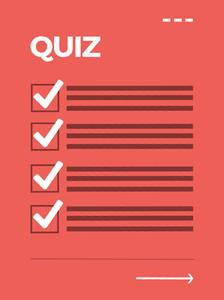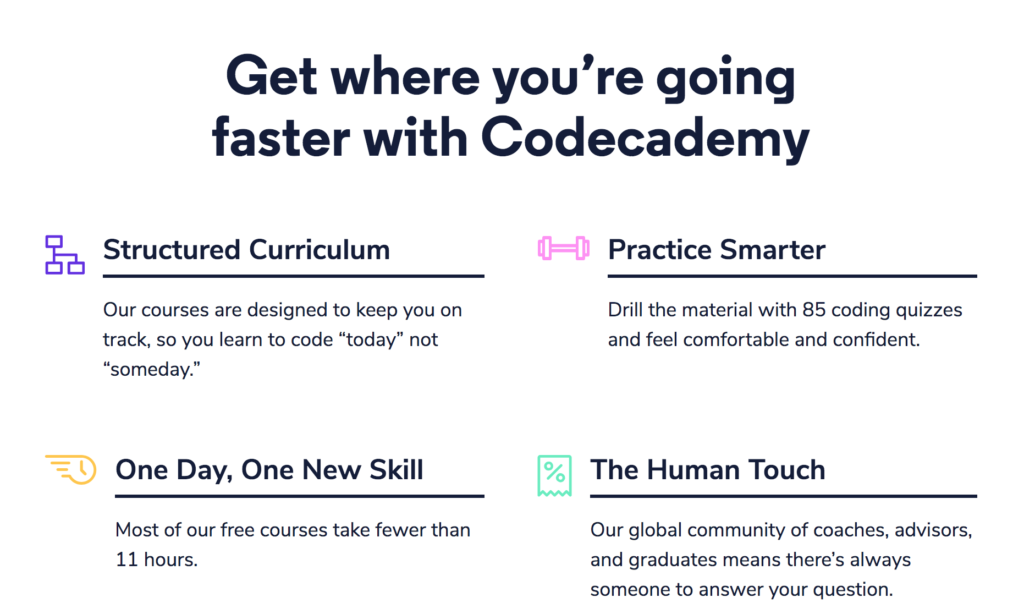
Find Out in Three Minutes (or Less!) If a Career in Tech Is Right for You
Our quick and easy quiz will help you pinpoint exactly how to get started in tech, in hardly any time at all.
I taught myself the basics of coding from a bunch of online tutorials that have long-since become obsolete and disappeared from the web. Back then, there weren’t really any interactive tutorials, just basic how-tos that you could try on your own. It was a whole lot of trial-and-error (and not a small amount of frustration).
If you’ve done any research about learning how to code, then I’m sure you’ve come across Codecademy. As one of the largest online coding schools, it’s pretty hard not to run into some
mention of this organization.
Codecademy offers plenty of advantages over the way I first learned to code, and I would have jumped at the chance to use a site like it when I was teaching myself.
But that doesn’t necessarily mean that they’re the best way to learn for everyone. To that end, I’ve put together three reasons you should use Codecademy, and four things you’ll want to look for when you get really serious about learning to code.
Psst! You can get started learning tech skills with Skillcrush’s FREE 10-day Coding Bootcamp! You’ll learn the basics of how to talk like a developer, what a career in tech is really like, and more.
Table of Contents
- 3 Reasons to Learn Code with Codecademy
- 4 Things to Look for in any Online Coding Course
- The Takeaway: Should You Use Codecademy?
3 Reasons to Learn Code with Codecademy
There are some definite advantages to learning to code with Codecademy. They’ve helped more than 24 million students learn to code.
Here are three reasons you should definitely consider using Codecademy to learn coding skills, especially when you’re first starting out:

1. It’s Free
Let’s get this one out of the way first. Like the image above from Codeacademy’s homepage states, one of the biggest advantages they have over a lot of other companies that teach coding online is that it’s free.
You don’t have to sign up for a monthly subscription or pay by the class. For someone on a tight budget, that can be the deciding factor. And when a course is free, it automatically has a higher ROI (since the investment is just time, not time + money).
So obviously, if you’re just starting out learning to code and you’re not sure if it’s for you or not, then trying out some completely free classes is an enticing place to start.
2. It takes care of all the setup work for you
One of the most annoyingly difficult things about learning to code is that oftentimes, the setup work is the hardest part. And that means that a lot of beginners never even have a fighting chance.
This isn’t the case when you’re learning frontend languages like HTML, CSS, and JavaScript. But if you’ve ever tried to noodle around with backend languages like PHP, Ruby, or Python then YOU KNOW.
To even write a simple “Hello World” app on your local computer in Ruby you have to go through hours of computer set up installing Ruby, making sure all the “packages” are right, reconfiguring folder permissions, getting your server running, figuring out how to connect to your browser if you’re so inclined…
Just imagine hours of your day spent in the terminal trying to make sense of strange error messages you’ve never seen.
What Codecademy has done so brilliantly, is make it possible for you to learn the syntax of a programming language via an interactive experience in your web browser. No setup time, whatsoever.
Yes, this IS learning to code with training wheels, but when you’re a complete beginner training wheels are 100% appropriate.
3. Codecademy covers a TON of languages and topics
Codecademy is nothing if not prolific, and one of their best features is just the breadth of their offerings. To date they have tutorials on HTML, CSS, Sass, JavaScript, Rails, AngularJS, ReactJS, Ruby, Command Line, Git, SQL, and Java. More than enough to keep you busy for a while, and more than enough opportunities for you to determine whether you like this whole coding thing and want to give it a real go.
Check out this article on How to Decide Which Programming Language to Learn if you’re overwhelmed with your choices starting out.
(back to top)

Find Out in Three Minutes (or Less!) If a Career in Tech Is Right for You
Our quick and easy quiz will help you pinpoint exactly how to get started in tech, in hardly any time at all.
What to Look for in Online Courses if You’re Serious About Learning to Code
When you first start to learn to code, a site that’s free and has a super low barrier to entry is the perfect place to begin. And when you start getting serious about learning to code especially if you want to make a career change, this is what you’ll want to do next:
1. Find instructors or mentors who can support you

Look, as much as we love interactive online tutorials here at Skillcrush, nothing can take the place of our real, live, human instructors and mentors who are there to help you as you’re learning to code (and the community of fellow students who back up that one-on-one experience). Codeacademy’s answer to the need for community is their forums, as you can see from the image above, taken from their homepage.
If you’ve ever tried to teach yourself something like code, you’ve probably found that you’ll likely run into problems you can’t immediately figure out. That’s when having a dedicated instructor and classmates who are working through the same courses you are is invaluable.
Knowing that you have support at every step of the way, from instructors who work in the subjects they teach every day, and classmates who got the same class email you did that morning, gives a sense of community that makes it way easier to stay motivated and on track while you learn.
With companies like Skillcrush, you even have video chat office hours with your instructor and other students to get answers to your questions or help with pieces where you might get stuck.
2. You need to get off the web (and suffer through all that annoying setup stuff)
Remember all that miserable setup stuff I mentioned earlier? Well, guess what? That stuff comes with being a coder. Sorry!
As much as it’s fun to code in an interactive tutorial, at the end of the day, that’s not real life. Eventually it will be time to take off those training wheels and learn how to write code the way professional developers do it.
And yes, that means you have to figure out how to install the languages and get them up and running and no, it won’t be easy or fun, but if you’ve got a few friends in your corner (see #1) you’re going to be alright!
3. You need to learn to think like a programmer
Becoming a programmer or developer doesn’t just mean that you know how to write syntax (the rules for the language the code is written in). You have to be able to solve problems using code, without anyone walking you through how to do it!
While knowing the technical specifics of a coding language is great, knowing how to actually apply that code to real-world situations is a critical part. This is where the rubber hits the road baby and you need practice!
Yes, after your time on Codecademy you’ll absolutely know how to write well-formatted JavaScript, Ruby, and who knows what else, and then it will be time for you to take your fancy coding skills and use ‘em to tackle some real life coding problems. Like, what time is it in Russia right now or how do you build an interactive quiz?
4. And tackle the not so exciting parts, too
Coding can be hard. It takes practice, it doesn’t always work the way you think it should, and sometimes you run into glitches and bugs that take a while to work out. That’s part of being a developer.
You need to learn to tackle the frustrating parts: to debug your own code when something doesn’t work right, to experiment with a new technique until you get it to work, or, in the worst case, to scrap something and start over with a different approach.
But don’t think of this like the bad part, this is the FUN part! The more you learn to enjoy the uncomfortable, the more successful you will be. And intentionally subjecting yourself to those types of experiences will teach you how to handle the hard parts of working as a developer so you don’t get discouraged and give up.
(back to top)
Takeaway: Codecademy is a Perfect Starting Point, But You’re Going to Need More
If you’re just getting started learn to code, Codecademy is a great way to get a sense for what coding is and how it works. It’s also a great free way to see if coding might be something that speaks to you as a potential career option before jumping in with both feet.
However, taking advantage of lots of different learning opportunities is part of building your proficiency faster. When you’re starting to to code, Codecademy should be just one of many good resources you have in your toolbox. Check out this roundup of 64 Online Resources to Learn to Code for Free for even more options.
Another great, free way to get started when you’re learning to code is to take Skillcrush’s 10-day Coding Bootcamp to learn the basics of what a career in tech is all about, and learn to start talking like a programmer.
Aaand, when it’s time to take those training wheels off and level-up, you can start looking at paid, instructor-led options like Skillcrush’s Blueprint Courses. These online classes are designed to be completed in just 3-4 months by spending only an hour a day on the materials.
(back to top)